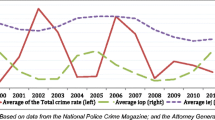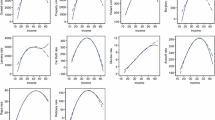Abstract
This paper exploits a dynamic panel data model to analyze the endogeneity of certain deterrent covariates, measurement errors in crime and inertial features of crime, and to check for unobserved heterogeneity in order to extract more precise and reliable estimates of the deterrent effect of law enforcement in North Carolina. It uses panel data on 90 counties of North Carolina over the period 2003–2012. After checking various socioeconomic covariates, among the deterrent variables, likelihood of arrest and conviction always showed deterrent effects on criminal behavior for different kinds of violent and property crimes. Since property crimes have relatively higher inertia than violent crimes, their associated long-run elasticities with respect to significant deterrence variables are greater, which implies that allocating more resources to increasing the likelihood of arrest for property crimes can effectively decrease them in the long run.
Similar content being viewed by others
Notes
The results of different identification tests are available on request.
However, using the updated data set, we tested Baltagi’s conjecture on consistency of the EC2SLS estimator. In our case, the Hausman-type test based on difference between FE2SLS and EC2SLS rejected the consistency of EC2SLS.
For a comprehensive explanation of instrument proliferation in DPD models, see Roodman (2009a).
We apply the command “xtabond2” for estimation of Difference GMM and System GMM in Stata. It is easy to restrict the number of instruments by the options available in this command.
The long-run effect is calculated as \(\frac{\beta }{1-\alpha _1}\), where \(\beta \) is estimated short-run elasticity and \(\alpha _1\) is the estimated coefficient for lagged crime rate.
References
Arellano M (2003) Panel data econometrics. Oxford University Press, New York
Arellano M, Bond S (1991) Some tests of specification for panel data: Monte Carlo evidence and application to employment equation. Rev Econ Stud 58(2):277–297
Arellano M, Bover O (1995) Another look at the instrumental-variable estimation of error component models. J Econom 68(1):29–52
Baltagi BH (2004) A Hausman test based on the difference between fixed effects two-stage least squares and error components two-stage least squares. Econom Theory 20:223–224
Baltagi BH (2006) Estimating an economic model of crime using panel data from North Carolina. J Appl Econom 21:543–547
Baltagi BH (1981) Simultaneous equations with error components. J Econom 17:189–200
Baltagi BH (2013) Econometric analysis of panel data, 5th edn. Wiley, Chichester
Becker G (1968) Crime and punishment: an economic approach. J Polit Econ 76(2):169–217
Blundell R, Bond S (1998) Initial conditions and moment restrictions in dynamic panel data models. J Econom 87(1):115–143
Blundell R, Bond S, Windmeijer F (2001) Estimation in dynamic panel data models: improving on the performance of the standard GMM estimator. In: Baltagi BH, Fomby TB, Carter Hill R (eds) Nonstationary Panels, panel cointegration, and dynamic panels. Advances in econometrics, 15th edn. Emerald Group Publishing Limited, Bingley, pp 53–91
Cherry T, List J (2002) Aggregation bias in the economic model of crime. Econ Lett 75:81–86
Cornwell C, Trumbull WN (1994) Estimating the economic model of crime with panel data. Rev Econ Stat 76:360–366
Ehrlich I (1973) Participation in illegitimate activities: a theoretical and empirical investigation. J Polit Econ 81:521–567
Fajnzilber P et al (2002) Inequality and violent crime. J Law Econ 45(1):1–40
Glaeser E et al (1996) Crime and social interactions. Q J Econ 111(2):507–548
Grogger J (1995) The effects of arrest on the employment and earning of young men. Q J Econ 110(1):51–72
Hansen LP (1982) Large sample properties of generalized method of moments estimators. Econometrica 50:1029–1054
Han et al (2014) Determinants of violent and property crimes in England and Wales: a panel data analysis. Appl Econ 45(35):4820–4830
Nickell S (1981) Biases in dynamic models with fixed effects. Econometrica 49:1417–1426
Roodman D (2009a) A note on the theme of too many instruments. Oxf Bull Econ Stat 71:135–158
Roodman D (2009b) How to do xtabond2: an introduction to difference and system GMM in Stata. Stata J 9:86–136
Windmeijer F (2005) A finite sample correction for the variance of linear efficient two-step GMM estimators. J Econom 126:25–51
Author information
Authors and Affiliations
Corresponding author
Rights and permissions
About this article
Cite this article
Ghasemi, M. Crime and punishment: evidence from dynamic panel data model for North Carolina (2003–2012). Empir Econ 52, 723–730 (2017). https://doi.org/10.1007/s00181-016-1093-5
Received:
Accepted:
Published:
Issue Date:
DOI: https://doi.org/10.1007/s00181-016-1093-5




